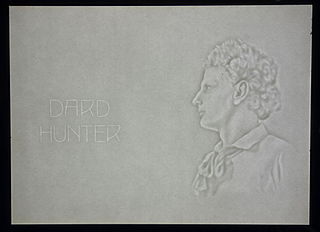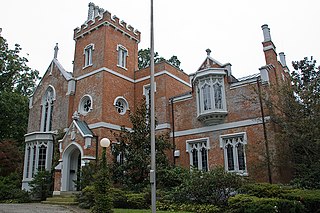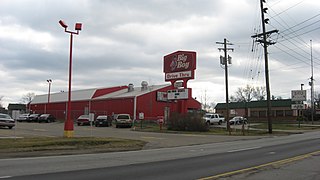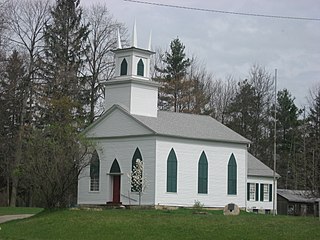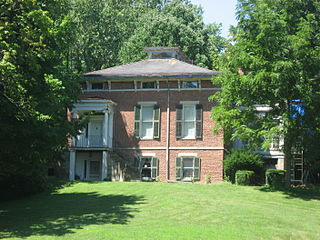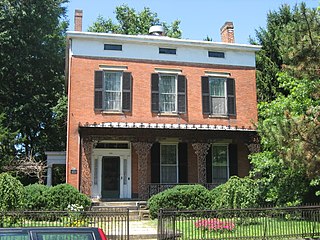Mountain House | |
Street view of the Mountain House | |
| Location | Highland Ave., Chillicothe, Ohio |
|---|---|
| Coordinates | 39°19′55″N82°59′29″W / 39.33194°N 82.99139°W Coordinates: 39°19′55″N82°59′29″W / 39.33194°N 82.99139°W |
| Area | less than one acre |
| Built | 1852 |
| Architect | Oscar Janssen |
| Architectural style | Gothic Revival, Romanesque Revival |
| NRHP reference # | 78002181 [1] |
| Added to NRHP | December 29, 1978 |
The Mountain House is a historic Gothic Revival house in western Chillicothe, Ohio, United States. [1] It was built by German immigrant Oscar Janssen in 1852, sitting atop a bluff above the Scioto River and the rest of the city of Chillicothe; its location and architectural style were intended to resemble that of castles overlooking the Rhine in his homeland. Janssen surrounded his house with vineyards, a winery, and a beer garden; because of the house's location on the edge of a steep hillside, he terraced the hillside before developing it. After Janssen's lifetime, the Mountain House passed into the hands of designer and papermaker Dard Hunter. Purchasing the house in 1919, Hunter converted it into a production center for his handmade paper and hand-carven type. Here he produced a wide range of books, publishing them under the banner of the Mountain House Press, and gradually he built a worldwide reputation. [2]

Gothic Revival is an architectural movement popular in the Western world that began in the late 1740s in England. Its popularity grew rapidly in the early 19th century, when increasingly serious and learned admirers of neo-Gothic styles sought to revive medieval Gothic architecture, in contrast to the neoclassical styles prevalent at the time. Gothic Revival draws features from the original Gothic style, including decorative patterns, finials, lancet windows, hood moulds and label stops.
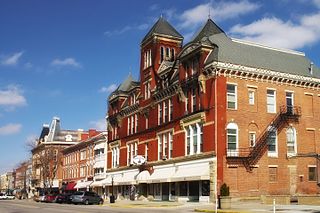
Chillicothe is a city in and the county seat of Ross County, Ohio, United States. Located along the Scioto River 45 miles south of Columbus, Chillicothe was the first and third capital of Ohio.

Ohio is a Midwestern state in the Great Lakes region of the United States. Of the fifty states, it is the 34th largest by area, the seventh most populous, and the tenth most densely populated. The state's capital and largest city is Columbus.
The two-story Mountain House mixes various architectural styles and materials. Although it is primarily a Gothic Revival structure, with details such as Gothic arches for windows and doors, it also includes a significant number of Romanesque Revival elements. [2] Its brick walls rest on a stone foundation, [3] and the interior may be accessed through large wooden doors. [2]

A storey or story is any level part of a building with a floor that could be used by people. The plurals are "storeys" and "stories", respectively.

An ogive is the roundly tapered end of a two-dimensional or three-dimensional object. Ogive curves and surfaces are used in engineering, architecture and woodworking.

Romanesque Revival is a style of building employed beginning in the mid-19th century inspired by the 11th- and 12th-century Romanesque architecture. Unlike the historic Romanesque style, however, Romanesque Revival buildings tended to feature more simplified arches and windows than their historic counterparts.
In 1978, the Mountain House was listed on the National Register of Historic Places. [1] It qualified for this distinction both because of its well-preserved historic architecture and because of its connection to Hunter, who was seen as a significant person in local history. [3] Today, the house remains in use as the offices of the Mountain House Press. [4]

The National Register of Historic Places (NRHP) is the United States federal government's official list of districts, sites, buildings, structures, and objects deemed worthy of preservation for their historical significance. A property listed in the National Register, or located within a National Register Historic District, may qualify for tax incentives derived from the total value of expenses incurred preserving the property.



